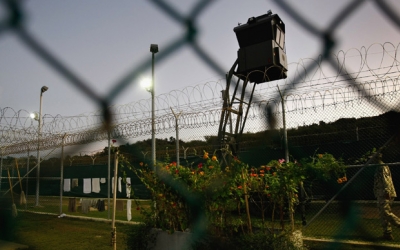Guantanamo: Yemeni detainee cleared for release after 20 years

A Yemeni national who has been detained without charge at Guantanamo Bay for 20 years has been cleared for release but will remain imprisoned until he is transferred out of prison.
Khalid Ahmed Qasim was cleared for release on Tuesday by a unanimous decision from the Periodic Review Board - a group of six federal US agencies. The review board reported that Qasim had made "threatening statements" within the last year but deemed that any threat could be mitigated, considering his "low level of training and lack of a leadership role" in either al-Qaeda or the Taliban.
Qasim has been imprisoned at Guantanamo since May 2002, making him one of the longest-detained persons at the prison.
"We're thrilled that after two decades imprisoned without charge or trial, Khalid has finally been cleared for release and can start to focus on his life after release," Mark Maher, Qasim's attorney, said in a statement on Wednesday.
"Khalid was a young man when he was detained and has developed into a talented artist and writer. He has a lot to offer the world, and we look forward to the day when he is finally free."
New MEE newsletter: Jerusalem Dispatch
Sign up to get the latest insights and analysis on Israel-Palestine, alongside Turkey Unpacked and other MEE newsletters
It is unclear where he will be transferred to, but the Periodic Review Board called for a "transfer to a country with a strong rehabilitation and reintegration program and appropriate security assurances as agreed to by the relevant USG departments and agencies".
"Khalid is still in Guantanamo, but we hope the administration will move quickly to have him transferred out so he can start his life as a free man," Maher told Middle East Eye in an email.
Guantanamo's ageing population
Qasim is one of 14 Yemenis still currently detained in the US detention facility. In total, 37 people still remain imprisoned at Guantanamo and the number of detainees recommended for transfer is 20, more than 50 percent of the population.
According to the rights group Reprieve, Qasim was arrested in December 2001 while in Afghanistan by the Northern Alliance, one of the factions in the country's civil war. After being severely tortured and making false confessions, he was sold to the US for a bounty.
While Qasim thought being put into US custody would be the last of his troubles, and that American soldiers would protect him from abuse, he was first sent to the notorious prison at Bagram in Afghanistan and then the US base at Kandahar where he was subject to freezing temperatures and sleep deprivation.
Then in May 2002, he was transferred to the detention centre at Guantanamo Bay where he remains today.
"Despite my negative legal status I am still able, with God’s help, to maintain a positive attitude to the point that all those I come in contact with are usually surprised by my positivity," he told his lawyer in 2020.
The Biden administration has said it plans to close the prison at Guantanamo Bay, but so far since coming into office, it has released only three detainees. During former President Donald Trump's four years in office, only one man - a Saudi citizen who was cleared under the Obama administration - was released.
Former Guantanamo detainees and defence lawyers have expressed concerns for the prison's ageing population, and a Covid-19 outbreak in the prison last month caused grave concerns for the health and safety of the prisoners.
Middle East Eye delivers independent and unrivalled coverage and analysis of the Middle East, North Africa and beyond. To learn more about republishing this content and the associated fees, please fill out this form. More about MEE can be found here.





